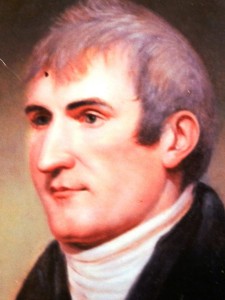‘2012 Journey’ Category
» posted on Tuesday, August 21st, 2012 by Linda Lou Burton
Enticements
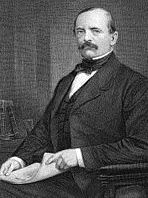 Linda Burton posting from Bismarck, North Dakota – I got a mouthful of information from City Portrait on Bismarck’s official website. It says “On July 17, 1873, Bismarck was named in honor of Germany’s “Iron Chancellor” Prince Baron Otto Eduard Leopold Von Bismarck-Schoenhausen, a famous German statesman from Prussia, credited with the creation of the German Empire and serving as her first chancellor.” I wanted to make the connection between Bismarck’s name and the area around Bismarck known as “the German-Russian Triangle.” It’s also called the “Sauerkraut Triangle,” and is one of the most homogeneous ethnic German-Russian enclaves in existence today; in six North Dakota counties at least 75 percent of the people claim German ancestry. So, why was Bismarck named Bismarck? It’s a story of enticement, and railroads. » read more
Linda Burton posting from Bismarck, North Dakota – I got a mouthful of information from City Portrait on Bismarck’s official website. It says “On July 17, 1873, Bismarck was named in honor of Germany’s “Iron Chancellor” Prince Baron Otto Eduard Leopold Von Bismarck-Schoenhausen, a famous German statesman from Prussia, credited with the creation of the German Empire and serving as her first chancellor.” I wanted to make the connection between Bismarck’s name and the area around Bismarck known as “the German-Russian Triangle.” It’s also called the “Sauerkraut Triangle,” and is one of the most homogeneous ethnic German-Russian enclaves in existence today; in six North Dakota counties at least 75 percent of the people claim German ancestry. So, why was Bismarck named Bismarck? It’s a story of enticement, and railroads. » read more
» posted on Monday, August 20th, 2012 by Linda Lou Burton
Beyond Numbers
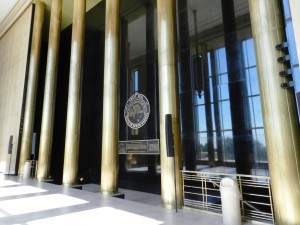 Linda Burton posting from Bismarck, North Dakota – “Over 80 percent of this capitol building is usable space,” the tour guide said. “As compared to Minnesota, say, where they can use only 29 percent. They have that big dome.” The guide has more numbers and comparisons; the North Dakota capitol cost $2 million to build in 1934, the Nebraska capitol, also a highrise, cost $11 million, she says. That’s $.46 per square foot vs $1.10. Frugality was a major consideration when building the North Dakota capitol; this is a state that simply doesn’t spend what it doesn’t have. After the old capitol burned in 1930, they sold 160 acres of land and used insurance money from the burned building to pay for the new capitol. Workers threatened a strike part-way
Linda Burton posting from Bismarck, North Dakota – “Over 80 percent of this capitol building is usable space,” the tour guide said. “As compared to Minnesota, say, where they can use only 29 percent. They have that big dome.” The guide has more numbers and comparisons; the North Dakota capitol cost $2 million to build in 1934, the Nebraska capitol, also a highrise, cost $11 million, she says. That’s $.46 per square foot vs $1.10. Frugality was a major consideration when building the North Dakota capitol; this is a state that simply doesn’t spend what it doesn’t have. After the old capitol burned in 1930, they sold 160 acres of land and used insurance money from the burned building to pay for the new capitol. Workers threatened a strike part-way 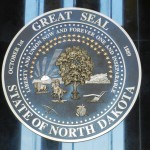 through; laborers asked for a raise from 30 cents an hour to 50. The governor called out the National Guard to protect the partially constructed building; workers were granted a 10 cent raise. Work continued, and the building was first occupied in January 1935. On time, and on budget. One thing I noticed right away; planning may have focused on frugal, and the outside may appear plain, but the building is impressive in its indoor elegance, and its streamlined efficiency. » read more
through; laborers asked for a raise from 30 cents an hour to 50. The governor called out the National Guard to protect the partially constructed building; workers were granted a 10 cent raise. Work continued, and the building was first occupied in January 1935. On time, and on budget. One thing I noticed right away; planning may have focused on frugal, and the outside may appear plain, but the building is impressive in its indoor elegance, and its streamlined efficiency. » read more
» posted on Sunday, August 19th, 2012 by Linda Lou Burton
Lay of the Land
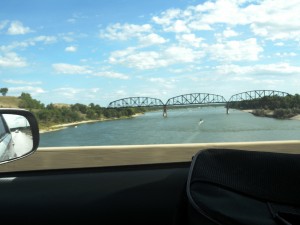 Linda Burton posting from Bismarck, North Dakota – I vaguely remember crossing the Missouri River coming into town on Friday; the GPS was on the blink so I was paying more attention to road signs than anything else. I also vaguely remember crossing a Time Zone advisory; it happened just a few miles before I got to town. For a reason I don’t know yet, half of North Dakota is on Mountain Time; the other half on Central. So, to orient myself, I’m on Central Time now, I’m east of the Missouri River; and I’m in the prairie. It is flat here. From the top of the freeway overpass I can see a hundred miles in every direction. Flat. Today I’m studying the map I got
Linda Burton posting from Bismarck, North Dakota – I vaguely remember crossing the Missouri River coming into town on Friday; the GPS was on the blink so I was paying more attention to road signs than anything else. I also vaguely remember crossing a Time Zone advisory; it happened just a few miles before I got to town. For a reason I don’t know yet, half of North Dakota is on Mountain Time; the other half on Central. So, to orient myself, I’m on Central Time now, I’m east of the Missouri River; and I’m in the prairie. It is flat here. From the top of the freeway overpass I can see a hundred miles in every direction. Flat. Today I’m studying the map I got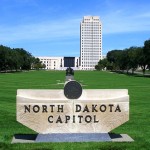 from the front desk. The weather report I hear on TV refers to Bismarck-Mandan; studying the map I can see why. Bismarck is in Burleigh County; Mandan is just across the river in Morton County to the west. But for purposes of weather, and entertainment, they seem to function as one and the same. The State Capitol (in Bismarck) is only blocks from I-94, take State Street south, turn right. It’s the first high-rise capitol on the Journey, 19 stories rising up above the plains. The Heritage Center, North Dakota’s state museum, is right beside. I see that the Bismarck Expressway circles south below the main part of town and over into Mandan; another bridge across the Missouri. » read more
from the front desk. The weather report I hear on TV refers to Bismarck-Mandan; studying the map I can see why. Bismarck is in Burleigh County; Mandan is just across the river in Morton County to the west. But for purposes of weather, and entertainment, they seem to function as one and the same. The State Capitol (in Bismarck) is only blocks from I-94, take State Street south, turn right. It’s the first high-rise capitol on the Journey, 19 stories rising up above the plains. The Heritage Center, North Dakota’s state museum, is right beside. I see that the Bismarck Expressway circles south below the main part of town and over into Mandan; another bridge across the Missouri. » read more
» posted on Saturday, August 18th, 2012 by Linda Lou Burton
Sky High
 Linda Burton posting from Bismarck, North Dakota – “Everything’s high in Bismarck,” was the answer I got. “Just wait till you see the price of orange juice when you go to the store.” I’d anticipated summer tourist room rates in Honolulu and Juneau, but Bismarck rates were a surprise. I was too tired last night to look elsewhere; I only removed from the car the items that would get us through the night. My room was sparkling clean and modern, tastefully furnished, overlooking a pretty rock garden and a row of trees between the building and the street. But it was not much bigger than its double bed; there was no work space for my computer; how could I live in such a tight space for two weeks? The manager brought a table and a chair and an extension cord; I thanked him yet began an online search for a bigger place, at a better rate. I found no better deal, but I found the answer to my question “Why so high?” It’s Williston, North Dakota, some 200 miles northwest of here. Williston is called Kuwait on the Prairie now, where 100 new oil wells are drilled every day by some 150 oil companies that have come here since 2006. Sister, there’s an oil boom going on. » read more
Linda Burton posting from Bismarck, North Dakota – “Everything’s high in Bismarck,” was the answer I got. “Just wait till you see the price of orange juice when you go to the store.” I’d anticipated summer tourist room rates in Honolulu and Juneau, but Bismarck rates were a surprise. I was too tired last night to look elsewhere; I only removed from the car the items that would get us through the night. My room was sparkling clean and modern, tastefully furnished, overlooking a pretty rock garden and a row of trees between the building and the street. But it was not much bigger than its double bed; there was no work space for my computer; how could I live in such a tight space for two weeks? The manager brought a table and a chair and an extension cord; I thanked him yet began an online search for a bigger place, at a better rate. I found no better deal, but I found the answer to my question “Why so high?” It’s Williston, North Dakota, some 200 miles northwest of here. Williston is called Kuwait on the Prairie now, where 100 new oil wells are drilled every day by some 150 oil companies that have come here since 2006. Sister, there’s an oil boom going on. » read more
» posted on Thursday, August 16th, 2012 by Linda Lou Burton
Pomp, and Circumstances
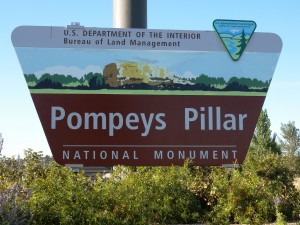 Linda Burton posting from Forsyth, Montana while traveling from Helena, Montana to Bismarck, North Dakota –I could see the Sleeping Giant across the valley this morning; the smoky haze was gone. No sleeping for me however; it was time to leave Helena; time to drive across Montana and see historic sights along the way. Too bad I wound up missing most of them, thanks to time spent trying to repair a malfunctioning GPS (an hour lost), time spent on teeth-jarring rutted roads (Highway 12 was de-paved for re-paving), and time spent searching for my wallet (it had bounced into the back seat under the cat supplies). Three hours behind and ravenous for
Linda Burton posting from Forsyth, Montana while traveling from Helena, Montana to Bismarck, North Dakota –I could see the Sleeping Giant across the valley this morning; the smoky haze was gone. No sleeping for me however; it was time to leave Helena; time to drive across Montana and see historic sights along the way. Too bad I wound up missing most of them, thanks to time spent trying to repair a malfunctioning GPS (an hour lost), time spent on teeth-jarring rutted roads (Highway 12 was de-paved for re-paving), and time spent searching for my wallet (it had bounced into the back seat under the cat supplies). Three hours behind and ravenous for  some lunch, I allowed a stop at Wheat Montana, (the famous bakery where John Dough Actually Lives). But I bypassed the Missouri Headwaters, where three rivers converge to mark the beginning of the Missouri. The History. July 28, 1805, Meriwether Lewis recorded in his journal “both Capt. Clark and myself… agreed to name them after the President of the United States and the Secretaries of the Treasury and State…we called the S.W. fork… Jefferson’s River in honor of Thomas Jefferson…the Middle fork we called Madison’s River in honor of James Madison and the S.E. Fork we called Gallitin’s River in honor of Albert Gallitin…the first two are 90 yards wide and the last is 70 yards…all of them with great velocity.”
some lunch, I allowed a stop at Wheat Montana, (the famous bakery where John Dough Actually Lives). But I bypassed the Missouri Headwaters, where three rivers converge to mark the beginning of the Missouri. The History. July 28, 1805, Meriwether Lewis recorded in his journal “both Capt. Clark and myself… agreed to name them after the President of the United States and the Secretaries of the Treasury and State…we called the S.W. fork… Jefferson’s River in honor of Thomas Jefferson…the Middle fork we called Madison’s River in honor of James Madison and the S.E. Fork we called Gallitin’s River in honor of Albert Gallitin…the first two are 90 yards wide and the last is 70 yards…all of them with great velocity.”
I missed Pompeys Pillar too, another integral part of the Lewis & Clark story, arriving nine minutes after the gates were locked. But Pomp’s is a story I’ll share with you anyway. » read more
» posted on Tuesday, August 14th, 2012 by Linda Lou Burton
On Watch
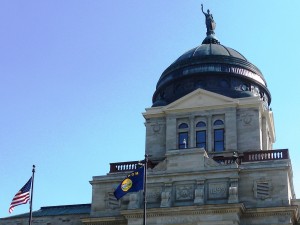 Linda Burton posting from Helena, Montana – The brisk hot wind had the flags at the State Capitol furled out full today, and Montana, the 17-foot statue atop the handsome copper dome, stood watch. From below, it’s hard to see the liberty cap Montana wears but we know it represents freedom. The literature tells us she holds three symbolic items – a shield for the United States, a laurel wreath for victory, and a torch to light the way. Governor Brian Schweitzer introduces the Capitol as the People’s House in the Montana Historical Society publication that is handed out to one and all; he calls it “a readily recognizable icon of democracy.” And the people come; to gather in solidarity or opposition, to speak their mind, to celebrate, or just to see. Washington DC-based Concerned Women for America (CWA) made a bus stop at the Capitol today, urging women of faith to register and vote in the 2012 elections. Inside, a Missoula group called the Blue Skies Campaign continued their week-long sit-in opposing coal development in eastern Montana. At the Visitor’s Desk a couple from Germany inquired about the significance of the Capitol’s copper dome; another couple stopped for directions to “the famous Russell painting.” I headed for the rotunda. » read more
Linda Burton posting from Helena, Montana – The brisk hot wind had the flags at the State Capitol furled out full today, and Montana, the 17-foot statue atop the handsome copper dome, stood watch. From below, it’s hard to see the liberty cap Montana wears but we know it represents freedom. The literature tells us she holds three symbolic items – a shield for the United States, a laurel wreath for victory, and a torch to light the way. Governor Brian Schweitzer introduces the Capitol as the People’s House in the Montana Historical Society publication that is handed out to one and all; he calls it “a readily recognizable icon of democracy.” And the people come; to gather in solidarity or opposition, to speak their mind, to celebrate, or just to see. Washington DC-based Concerned Women for America (CWA) made a bus stop at the Capitol today, urging women of faith to register and vote in the 2012 elections. Inside, a Missoula group called the Blue Skies Campaign continued their week-long sit-in opposing coal development in eastern Montana. At the Visitor’s Desk a couple from Germany inquired about the significance of the Capitol’s copper dome; another couple stopped for directions to “the famous Russell painting.” I headed for the rotunda. » read more
» posted on Monday, August 13th, 2012 by Linda Lou Burton
A Ton of Bricks
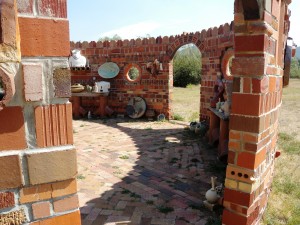 Linda Burton posting from Helena, Montana – If you’re going to lock your keys in your car you couldn’t choose a better place than “The Bray.” I heard about the Archie Bray Foundation for the Ceramic Arts the first day I arrived in Helena. Now (after that door-slam when you instantly realize your keys are still on the car seat) I’m sitting on the steps of their office waiting for AAA to arrive with the unlocking thing-a-majig. I’ve got one eye on the Scion and the other on an interesting circular structure just off to my right. The little brown brochure with a map of the place tells me it’s the Potter’s Shrine, built to reflect construction techniques used in the original buildings and to honor past and present ceramic artists at The Bray. It’s dedicated to Archie Bray, whose vision “gave birth to the Foundation” and it contains a bust of the man, sculpted by Rudy Autio in 1952. I started walking down the gravel drive and saw an array of brick buildings and chimneys and artworks scattered around this site that once was a brick factory, according to the brochure. A brick factory? A Foundation supporting ceramic artists? A man named Archie Bray? How did it all come together? » read more
Linda Burton posting from Helena, Montana – If you’re going to lock your keys in your car you couldn’t choose a better place than “The Bray.” I heard about the Archie Bray Foundation for the Ceramic Arts the first day I arrived in Helena. Now (after that door-slam when you instantly realize your keys are still on the car seat) I’m sitting on the steps of their office waiting for AAA to arrive with the unlocking thing-a-majig. I’ve got one eye on the Scion and the other on an interesting circular structure just off to my right. The little brown brochure with a map of the place tells me it’s the Potter’s Shrine, built to reflect construction techniques used in the original buildings and to honor past and present ceramic artists at The Bray. It’s dedicated to Archie Bray, whose vision “gave birth to the Foundation” and it contains a bust of the man, sculpted by Rudy Autio in 1952. I started walking down the gravel drive and saw an array of brick buildings and chimneys and artworks scattered around this site that once was a brick factory, according to the brochure. A brick factory? A Foundation supporting ceramic artists? A man named Archie Bray? How did it all come together? » read more
» posted on Sunday, August 12th, 2012 by Linda Lou Burton
Now and Then
Linda Burton posting from Helena, Montana – You can’t throw a rock around here without hitting something named Lewis and Clark. Helena is the county seat of Lewis and Clark County; the Lewis and Clark National Forest is all around. It’s no wonder their names are everywhere, because Meriwether Lewis and William Clark had quite an impact on this part of the country. And this part of the country had an impact on them, as we can read in their journals. We have the Missouri River to thank for their visit; one might say that in travel and exploration, mountains are walls and rivers are the roads through them. The Missouri River road brought Lewis and Clark (and Sacajawea) here; between July 16, 1805 and July 24 to be exact; their Journal entries tell us what they saw, what they did, and how they felt about it all. Lewis writes that they killed a buffalo near the river on July 16, and dined on it for breakfast. On the 17th he notes the sunflowers blooming abundantly in the river bottom. The next day he writes of his eagerness to meet up with the Shoshone as he hopes to get information from them. But it’s the entry of July 19 that stirs excitement for me today, as I head for the “gates of the mountains,” to see what Captain Lewis described in his journal. » read more
» posted on Saturday, August 11th, 2012 by Linda Lou Burton
Red Flag Flying
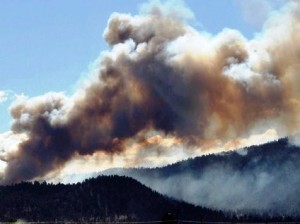 Linda Burton posting from Helena, Montana – I finally put two and two together this morning. My eyes had been burning like crazy for several days; no amount of eye drops seemed to help. Was I spending too much time staring at the computer screen? I’d had a nagging little night cough too; it seemed to begin when I opened the window for some fresh air as I went to bed. But come to think of it, I hadn’t been able to see the Sleeping Giant mountain for several days; the valley was covered in haze. Maybe the air wasn’t so fresh, after all. On my way to breakfast, I stopped at the front desk and asked. “Yes, there’s a forest fire burning to the north,” she confirmed. “All that smoke in the valley is bad for a person’s allergies.” Allergies, and eyes, I thought. Back in my room, I closed my window and sat down with my coffee to find what I could about forest fires in Montana. The InciWeb Incident Information System at the Montana State Travel Site quickly brought me up to date. http://visitmt.com/fire/conditions.htm » read more
Linda Burton posting from Helena, Montana – I finally put two and two together this morning. My eyes had been burning like crazy for several days; no amount of eye drops seemed to help. Was I spending too much time staring at the computer screen? I’d had a nagging little night cough too; it seemed to begin when I opened the window for some fresh air as I went to bed. But come to think of it, I hadn’t been able to see the Sleeping Giant mountain for several days; the valley was covered in haze. Maybe the air wasn’t so fresh, after all. On my way to breakfast, I stopped at the front desk and asked. “Yes, there’s a forest fire burning to the north,” she confirmed. “All that smoke in the valley is bad for a person’s allergies.” Allergies, and eyes, I thought. Back in my room, I closed my window and sat down with my coffee to find what I could about forest fires in Montana. The InciWeb Incident Information System at the Montana State Travel Site quickly brought me up to date. http://visitmt.com/fire/conditions.htm » read more
» posted on Friday, August 10th, 2012 by Linda Lou Burton
Talent Is
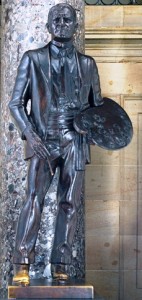 Linda Burton posting from Helena, Montana – “To have talent is no credit to its owner,” Charlie Russell said in 1925. “What man can’t help he should get neither credit nor blame for.” Charles Marion Russell (1864-1926) moved to Montana when he was sixteen, seeking the life of a cowboy. It wasn’t his talent, however; he was fired from his sheep-ranching job in just a few months. He followed Jake Hoover for a while, hunting and trapping; then hired on as a wrangler at a cattle ranch near Missoula. He was finally living the cowboy life, going on cattle drives; he continued this for seven years. He also spent a year with the Blackfoot Indians, learning their ceremonies, hunting methods, and tribal legends. He sketched and drew these things he experienced during a time of Montana’s vanishing frontier – the 1880’s and 1890’s. And Charlie Russell found his talent. He created more than 4,000 paintings, drawings, and sculptures in his lifetime, becoming one of the world’s best-known and most authentic western artists. Today his statue represents Montana in Statuary Hall in Washington, DC. As I read the story of this remarkable man, I see two significant marking points – in 1886 and in 1896 – when the talent he was so modest about began to be recognized. » read more
Linda Burton posting from Helena, Montana – “To have talent is no credit to its owner,” Charlie Russell said in 1925. “What man can’t help he should get neither credit nor blame for.” Charles Marion Russell (1864-1926) moved to Montana when he was sixteen, seeking the life of a cowboy. It wasn’t his talent, however; he was fired from his sheep-ranching job in just a few months. He followed Jake Hoover for a while, hunting and trapping; then hired on as a wrangler at a cattle ranch near Missoula. He was finally living the cowboy life, going on cattle drives; he continued this for seven years. He also spent a year with the Blackfoot Indians, learning their ceremonies, hunting methods, and tribal legends. He sketched and drew these things he experienced during a time of Montana’s vanishing frontier – the 1880’s and 1890’s. And Charlie Russell found his talent. He created more than 4,000 paintings, drawings, and sculptures in his lifetime, becoming one of the world’s best-known and most authentic western artists. Today his statue represents Montana in Statuary Hall in Washington, DC. As I read the story of this remarkable man, I see two significant marking points – in 1886 and in 1896 – when the talent he was so modest about began to be recognized. » read more

